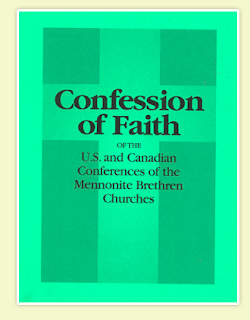“It is not exclusion to promote an identifiable standard of membership
in a Christian church. It is foolishness to think that a minority group could
expect to revise such a standard based on the preferences of that minority
group.”
That’s what a friend said about Mennonite Brethren churches that want to welcome and affirm LGBTQ+ people, including same-sex marriage, in contravention of the Confession of Faith.
I replied: “But that’s the thing, isn’t it? The standards change. At one time the standard said there could be no divorced members, no women in leadership, speaking German was the only acceptable language of worship, immersion was the only acceptable form of baptism, and marrying outside the Mennonite denomination could get you removed from membership."
I went on: "Those things were once all standards, but they aren’t any longer. And before you say LGBTQ+ is different because it is in the Bible, the Bible was once used to justify all these things, too. The world changed, people changed, theology changed.”
I haven’t got a response from him to that yet. But the exchange reminded me of a sermon Jon Isaak preached at River East Church in January.
In it Isaak, who directs the Centre for Mennonite Brethren Studies in Winnipeg, noted that things Mennonite Brethren once considered to be “standard” have indeed changed over the past 162 years of the denomination’s history.
Those changes include:
Spouses of Mennonite Brethren members who were baptized in modes other than immersion were, for years, forced to be rebaptized by immersion in order for the Mennonite Brethren spouse to avoid excommunication.\
The Lord’s Table: For years many Mennonite Brethren churches would not allow children and those who weren’t baptized to participate. Now most have a more open practice of communion.
Women in ministry leadership was once ruled out, but now is practiced to varying levels of support and encouragement in Canada.
Cremation was once taboo among Mennonite Brethren. But now it has become much more common.
As for the Confession of Faith itself, there have been four in the denomination’s history.
The 1853 Confession used by most other Mennonites in Ukraine was the one that was taken over without change when the Mennonite Brethren left to form their own church in 1860.
The 1902 Confession was the first one Mennonite Brethren wrote for themselves. It introduced two major changes—Baptist language of “personal conversion and assurance” in the salvation article and immersion language in the article on Baptism.
The 1975 Confession introduced no major changes, just some updating.
The 1999 Confession introduced a broader definition of sin as a systemic power field, and not limited to the personal sins of transgression. And the word “homosexuality” was introduced in Article 10 as simply the most grievous example of sexual immorality anyone could think of at the time, something that reflected most, if not all, evangelical thinking in the 1990s.
Since 1999, there have been two changes to the text of the Confession. In 2014, the American church decided to change Article 13, the one on love and non-resistance, to say now that “historically” many Mennonite Brethren have chosen to do alternative service in times of war; non-resistance is no longer the default expectation.
In 2021, the Canadian church decided to change Article 8, the one on baptism, softening the covenantal language with the church but keeping all the rest.
As Isaak put it, “the evidence for changes over time is clear. This should not surprise us. Usually, there are some social or cultural realities that eventually convince the majority of Mennonite Brethren on whatever topic that a change is needed.”
For him, these changes should not be dismissed automatically as cultural relativism, or as giving into culture and the world (although some would surely have made that argument at the time).
Rather, he said, “it is a sign of the incarnational character of the Judaeo-Christian tradition; it is a faith that is embodied in human cultures.”
As Isaak put it: “Confessions do develop, changing to keep pace with what God is doing in our world. In all these changes, it is important to note that the Bible has not changed, but the interpretation of the Bible has changed.”
And even within the Bible itself, he said, there are many examples of change and development—polytheism to monotheism, polygamy to monogamy, tribal governance to monarchy, Judaism as a closed ethnicity to a nonethnic, universal Judaism in Jesus, and so on.
“So, whether it is within the Bible, or our interpretations of the Bible, change and development are givens,” he said. “They are not things to be afraid of but rather to be processed responsibly and critically.”
Such changes are never easy or simple or obvious, and sometimes they are only made with great struggle, he said, adding "but they call for engagement as we discern together how best to represent Jesus in our worlds.”
The time could come to retire a Confession that is 162 years old, Isaak said. If that happens, one option would be to adopt the Mennonite World Conference Shared Convictions. It doesn’t get into the weeds about behaviours and doesn’t mention marriage or sexuality at all.
Either that, or use Palmer Becker’s threefold definition of Anabaptist Christianity, as adapted by Lynn Jost (who teaches Old Testament and preaching at Fresno Pacific University): Following Jesus is the centre of our faith; spirit-inspired community is the centre of our life; peacemaking is the centre of our mission.
As Isaak put it at the end of his sermon: “Embracing change,
development, and evolution is something not only visible in science, society,
and the environment, but it also applies to Christianity.” And maybe to confessions
of faith, as well.




No comments:
Post a Comment